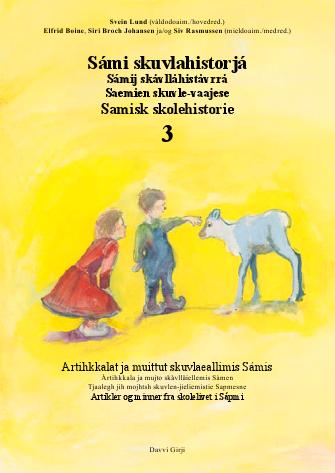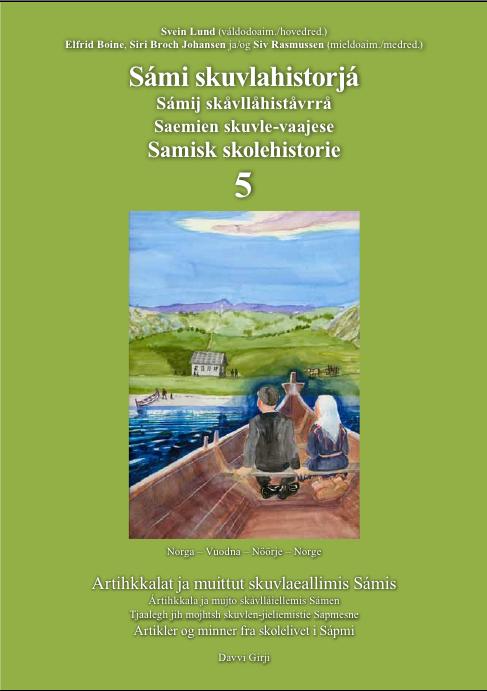 Sámegillii
Sámegillii  På norsk
På norsk
Articles about Sami school history
Part 27 - printed in Ávvir 11.02.2012
    
Do you know Sami school history?Sámi skuvlahistorjá / Samisk skolehistorie (Sami School History) is a series of books published by the publishing house Davvi Girji. In about 200 articles in 5 volumes there is told about the experiences of Sami children in Norwegian schools, and about the changes in the educational politics of the Norwegian authorities towards the Sami population. The books are published with parallell text in Sami and Norwegian language.In this web site some of the articles of the first book are also published in English. It would be too much to translate it all, so to make this history available to a greater public, we are translating a series of newspaper articles, which sorted by topics make a summary of stories in the books. So far there are 28 articles published in Sami language by the Sami newspapers Min Áigi and Ávvir. They are also published here in Norwegian and the English version will be published gradually as they are translated. These articles are edited by the main editor, Svein Lund. Besides him the editing board of the book series consist of Elfrid Boine, Siri Broch Johansen and Siv Rasmussen. |
When the national curriculum of 1939 does not mention the Sami by one word, but in the section of the history subject states that «Our forefathers was part of the Germanic lineage», it is legetimating and standardizing that the Sami and Kven population should be ignored in the teaching, that they are to be seen as non-excistent, both as pupils and as part of the Norwegian society. When the national curriculum of 2006 states as one of the aims in the subject of Food and health to «Prepare Sami food and account for some traits of the Sami food culture», it is a legitimation and standardization that the Sami minority in Norway should be seen in the school, and that it is important that all pupils get to know different sides of Sami culture. We will give some glimpses of the curriculums in Norway throughout the times and their relation to the Sami.
Maybe one did not know better back then? Maybe no one thought about these things? Yes, someone did, and already back in the 1920's demands for both teaching in Sami and Sami content in the school was raised, among others through Per Fokstad's Some hints to a proposal of a Sami (Lappish) curriculum, which he presented to the Parliamentary school commission. The commission's report of 1926 contains a separate chapter concerning the Sami and Kven school conditions. Various views are referred to in the chapter, among others Fokstad's curriculum and the view of the reindeer hearding inspector Kristian Nissen and the director of schools Chr. Brygfjeld, who both oppose the curriculum. The commission appointed a separate board to consider the question. This is how the board rejected Fokstad's proposal:
In other words the demand is that Norway should take care of developing a Sami spiritual culture, which is still non-existent. One could call this a beautiful thought; but it is a thought it is not possible to realize. ... The Sami have not developed a spiritual culture themselves, through a settled way of life adapted to culture, but only a culture which is most closely connected to the nomadic life. One has not made experiences that indicate that some other Sami culture would be possible to develop at all; the conditions for such a development is not there; the entire distinctive character and talents of this people are not leading in that direction, ... If one looks seriously at the conditions, one would have to say that the Sami in this country hardly have any chance to enter the cultural life without acquiring the Norwegian culture, first and foremost through learning to master the Norwegian language. ...
In accordance with what has been stated the commission finds that the work in the mixed language districts in general should continue on the trail that has been entered upon.
 |
The curriculum of 1939 ignored the Sami completely. |
The curriculum for Norwegian language starts with the conclusion: «The goal is to teach the children to speak their mother tongue naturally, easy and clear – without bigger mistakes in sound and grammar.» Once again the fact that the school had pupils with other mother tongues than Norwegian is completely ignored.
Still Norwegian equals mother tongue. Still Sami and Sami areas are barely mentioned. In Social subjects the aim among others is to «develop tolerance and respect for people of different skin colour, language, religion, traditions and view of society». Still the curriculum set up for the oposite when it comes to the Sami in Norway and the Sami pupils, in ignoring them consequently.
Sami are only mentioned in the Geography subject, where one of the exercises for the pupils is: «Recount the content of a book about a) Sami, b) Eskimos, c) Negroes in Africa, d) Negroes in America».
 |
The curriculum of 1974 was the first to contain Sami themes in many subjects. |
That the Sami were mentioned at all in the first report of 1970, was because Anton Hoëm, who had done research exactly on Sami school conditions, both asked for this from the Basic curriculum committee, and wrote suggestions for the text himself. A two page chapter on Sami speaking pupils in the primary school was then added to the preparations for basic curriculum for the primary school .The law of primary school from 1969 which states the right of teaching in Sami is referred to here. But the committee wants to postpone the questions concerning the Sami conditions until the basic plan is finished and later make a supplement. The conditions for Sami pupils was therefore postponed to the second report from the committee. It did not last long until there were reactions. The school council of Kautokeino was in the front rank of the critics, which in December the same year among others stated:
«a. The plan does not state that there are Sami speaking pupils in Norwegian schools and Sami culture in Norway.
b. The teaching of Sami speaking pupils has not been treated.
c. The aim for bilingualism Norwegian/Sami has not been treated, and not the difficulties concerning so-called language problems either.»
The critics from Kautokeino was probably one reason that a two-page chapter on «Pupils in mixed-language districts» was added to the temporary curriculum of 1971, although the content was far from what the critics had wished for. In this chapter it is written that Sami pupils can have basic teaching in Sami, but that «It is reasonable to assume that Sami and the Sami culture will dominate in the lowest level of the primary school, and that Norwegian language and Norwegian culture will substitute this place in the higher levels in the primary school.» In the singular subjects the Sami are mentioned directly only once: In the Orienteering subject for the 4. year the pupils are to learn about «Life in cold areas»: «The Tundra, Greenland, Canada: Eskimos, North-Scandinavia – Sami.»
Sami school environments strengthened the critics, and joined their forces in making changes in the final curriculum. In the spring of 1972 a great seminar was held in Kautokeino concerning the draft for the basic curriculum and the school situation of the Sami. The statements from this seminar were presented to Stortinget's church and educational committee.
The critics of M71 (the basic curriculum of 1971) was concerning both the position of Sami and Norwegian language in the teaching and the lack of Sami content in the singular curriculums. In the first area the results were poor. The formulation about changing to Norwegian as the main language was kept. On the other hand the Sami subject was taken into the curriculum, and several points concerning Sami conditions were taken into the curriculum in several subjects. The curriculum states no guidelines of what concerns the Sami areas and what concerns the rest of the country. All pupils in the country should in principle get this teaching on Sami conditions, but without teachers and textbook writers who had enough knowledge a lot would often lack that this was followed through.
 |
The first Sami curriculum of 1987. |
Sami educational council learned that the basic curriculum was to be revised and made an enquiry to the Ministry of church and education in 1984 suggesting to make a basic Sami curriculum. The Sami educational council was then asked to make curriculums, at first with Sami as first and second language. The council agreed, but at the same time demanded that there should be made separate Sami curriculums for all subjects.. ... Although we had to use the Norwegian curriculum M87 as our base, it was still the first Sami curriculum.» (SSH1)
In 1989 part 2 of the basic curriculum was published with Sami curriculums for seven subjects in the primary school. No guidelines were stated for who should make use of this curriculum. That matter was left to the single municipality or school. The curriculum was used to a greater or smaller extent in Kautokeino, Karasjok, Porsanger, Nesseby and in two schools in Tana and the special Sami schools in Målselv, Hattfjelldal and Snåsa. But even here the Sami curriculum was not used completely for everybody. Some schools only used part of the Sami curriculum, or they used it only in Sami speaking classes.
The national curriculums kept the paragraphs about Sami in some subjects. In other subjects the Sami topics were removed and only continued in the Sami curriculums. Consequently the national curriculums, which also the greatest part of the Sami pupils were taught by, had less content concerning the Sami matters after the M87 than after the M74.
But the curriculums from 1987/89 were not to be used untouched for a long time. Already in 1990 a new minister who wanted to remove the Sami curriculums completely entered the ministry. You can read about this in the next article.
Here you find all the articles in the series:
28.09.2007 Why Sami school history?
05.10.2007 Boundless ignorance
12.10.2007 Southerner-teachers encounter the Sami language
19.10.2007 The start of Sami beginner instruction
26.10.2007 The start of education in reindeer-herding
02.11.2007 From Sami to Norwegian vocational training
16.11.2007 Struggle for Sami gymnasium
28.11.2007 School experiences of Norwegian speaking Samis
14.12.2007 Resistence against Sami language and culture
25.01.2008 A strange world
23.05.2009 On Sami teachers
30.05.2009 Life in boarding school
06.06.2009 Sami pupils were bullied
13.06.2009 Sami content in the teaching
20.06.2009 Pupil as interpreter
04.07.2009 How the children quit speaking Sami
10.09.2010 God does not understand Sami
08.10.2010 The point of view of the Norwegianizers
13.10.2010 Men of the church defending the Sami language
02.12.2010 Sami teachers in old times
09.12.2010 Boarding school life in old times
18.12.2010 Sami pupils in special schools
14.01.2012 The parents' struggle for Sami education
21.01.2012 Reluctance and absence
28.01.2012 The school during the war
04.02.2012 Reconstruction and barrack schools
11.02.2012 Curriculums - for Norwegianization and for Sami school
18.02.2012 The great struggle of the curriculum
Sami school history 1
Sami school history 2
Sami school history 3
Sami school history 4
Sami school history 5
Sami school history - main page